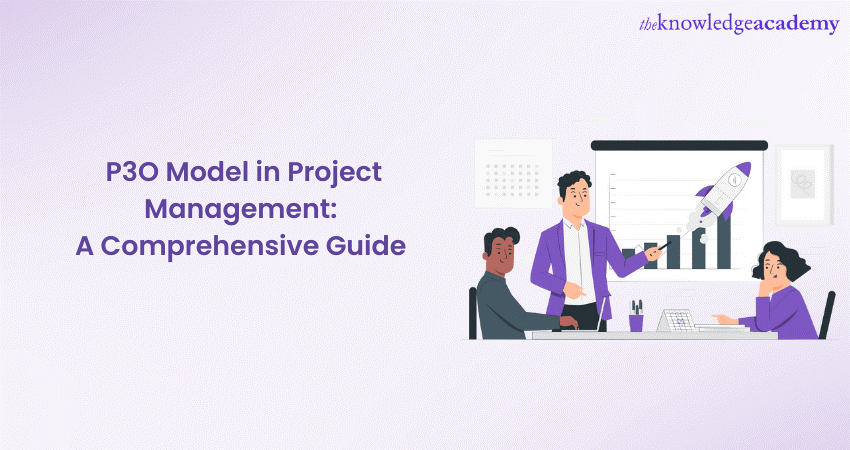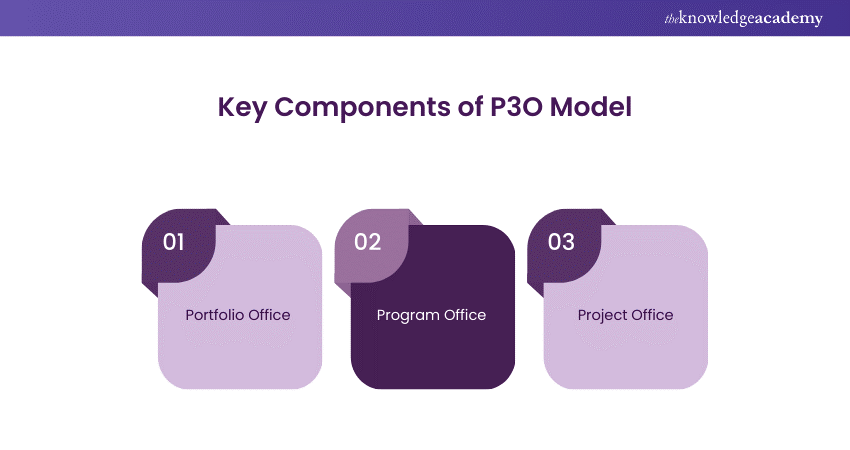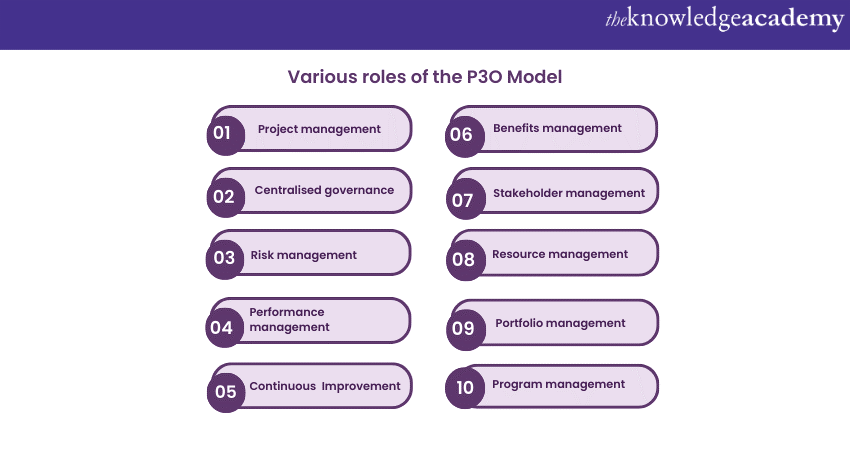We may not have the course you’re looking for. If you enquire or give us a call on 01344203999 and speak to our training experts, we may still be able to help with your training requirements.
Training Outcomes Within Your Budget!
We ensure quality, budget-alignment, and timely delivery by our expert instructors.

Organisations need a robust framework to manage their portfolios, programs, and projects effectively. This is where the P3O Model comes to play by curating centralised governance, risk management, performance management, benefits realisation, stakeholder engagement, and resource optimisation under one roof.
The model is designed to be capable of helping an organisation align its projects with its business goals. The P3O Model is a structured framework that establishes & manages offices responsible for effective portfolio, program, & project management.
Table of Contents
1) Overview of the P3O Model
2) Key components of P3O Model
a) Portfolio office
b) Program office
c) Project office
3) Various roles of the P3O Model in project management
4) Conclusion
Overview of the P3O Model
The P3O Model provides organisations with a structured framework to manage their portfolios, programs, and projects effectively. It acts as a central hub, bringing together strategic alignment, governance, and decision-making processes.
This model comprises three types of offices: Portfolio Office, Program Office, and Project Office. The Portfolio Office ensures strategic alignment, the Program Office focuses on program-level coordination and integration, and the Project Office supports individual projects.
Moreover, this model enables organisations to optimise resource allocation, mitigate risks, enhance value delivery, and improve overall project performance. It fosters a culture of transparency, collaboration, and informed decision-making, enabling organisations to achieve their strategic objectives successfully and efficiently.
Key components of P3O Model
The P3O Model comprises three essential components, each vital in helping organisations plan and execute their business processes. These components are discussed briefly in the following points:

Portfolio office
This component is the first part of this model, which focuses on strategic decision-making, overseeing the organisation's portfolio of programs and projects. Additionally, it ensures alignment with strategic objectives and manages business risks at a portfolio level.
Program office
This second component of this model focuses on managing programs within the organisation and providing support to program managers. Moreover, it ensures the coordination and integration of program activities, monitors program performance and progress, and facilitates communication between projects within the program.
Project office
This component is the third part of the P3O Model. It focuses on individual projects, providing support and guidance to project managers. It also ensures adherence to project management processes, monitoring performance, and managing project risks and issues.
Acquire the knowledge to operate on a P3O Model project, by signing up for the P3O Foundation Training Course now!
Various roles of the P3O Model in Project Management

The P3O Model is a structured approach to Project Management. Knowing about the P3O model it is equally important to know the benefits of P3O. Its value can be segregated into various points for further understanding, which are as follows:
a) Project management: This model provides a structured approach to project management, ensuring effective planning, execution, and control of projects to achieve desired outcomes.
b) Centralised governance: This model establishes a central governance structure, enabling consistent decision-making, accountability, and oversight across portfolios, programs, and projects.
c) Risk management: This model promotes proactive risk management, identifying and mitigating potential risks to minimise their impact on project success and enhance overall risk resilience.
d) Performance management: This model facilitates performance monitoring and measurement, allowing organisations to track project progress, identify areas for improvement, and ensure alignment with strategic objectives.
e) Continuous improvement: This model fosters a culture of continuous improvement, encouraging organisations to learn from past experiences, implement lessons learned, and enhance project management practices over time.
f) Benefits management: This model focuses on benefits realisation, ensuring that projects deliver the intended outcomes and align with the organisation's strategic goals.
g) Stakeholder management: This model emphasises effective stakeholder engagement and communication, ensuring that stakeholders are involved, informed, and supportive throughout the project lifecycle.
h) Resource management: This model optimises resource allocation, ensuring that the right resources are assigned to projects, promoting efficient utilisation, and maximising project delivery capabilities.
i) Portfolio management: This model drives strategic decision-making, prioritising projects, and allocating resources to achieve organisational goals. Portfolio management provides an organisation with a holistic view of its project landscape, enabling effective governance, risk management, and value delivery across the entire portfolio.
j) Program management: This model involves the coordination and integration of a set of related projects to achieve a common goal. Program management focuses on managing interdependencies, ensuring synergies between projects, and delivering strategic outcomes.
Design, implement, and work with a P3O Model, by signing up for the P3O Practitioner Training Course now!
Conclusion
This blog has discussed how the P3O Model offers a comprehensive framework to ensure Good P3O Culture in an Organisation. It helps them effectively manage their portfolios, programs, and projects. This framework combines centralised governance, risk management, performance management, continuous improvement, benefits management, stakeholder management, and resource management. Moreover, implementing the P3O Model can aid organisations in fostering transparency, collaboration, and value delivery across their departments and teams.
Make better informed decisions for your business processes, by signing up for the P3O Training Courses now!
Frequently Asked Questions
Upcoming Project Management Resources Batches & Dates
Date
 P3O® Foundation
P3O® Foundation
Mon 10th Jun 2024
Mon 8th Jul 2024
Mon 5th Aug 2024
Mon 2nd Sep 2024
Mon 7th Oct 2024
Mon 4th Nov 2024
Mon 2nd Dec 2024
Mon 6th Jan 2025
Mon 3rd Feb 2025
Mon 3rd Mar 2025
Mon 7th Apr 2025
Tue 6th May 2025
Mon 2nd Jun 2025
Mon 7th Jul 2025
Mon 4th Aug 2025
Mon 1st Sep 2025
Mon 6th Oct 2025
Mon 3rd Nov 2025
Mon 1st Dec 2025







 Top Rated Course
Top Rated Course



 If you wish to make any changes to your course, please
If you wish to make any changes to your course, please


